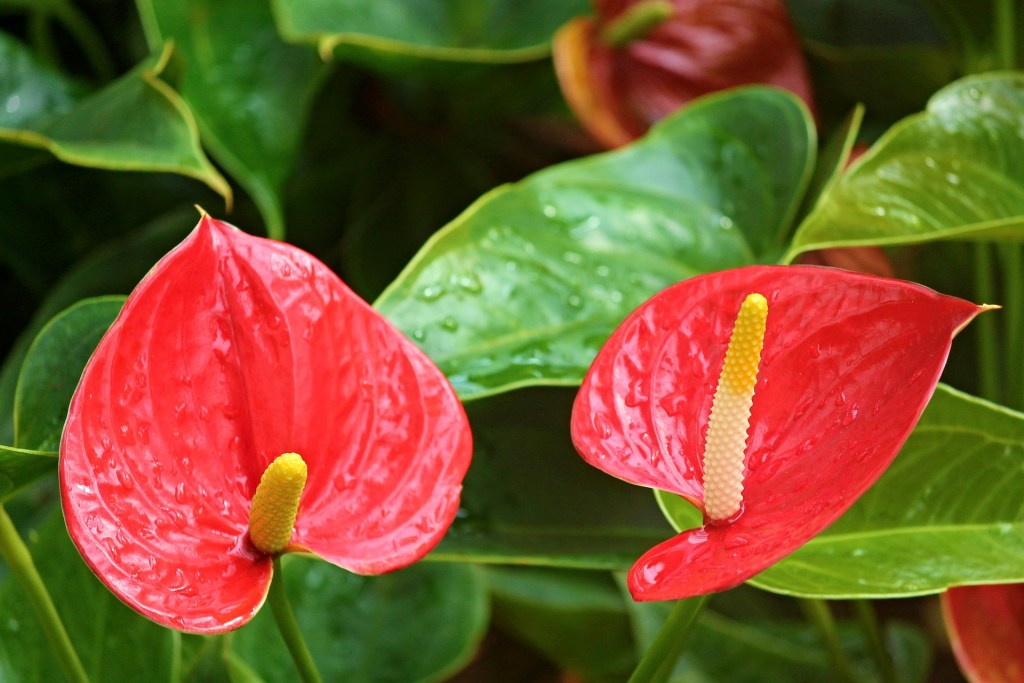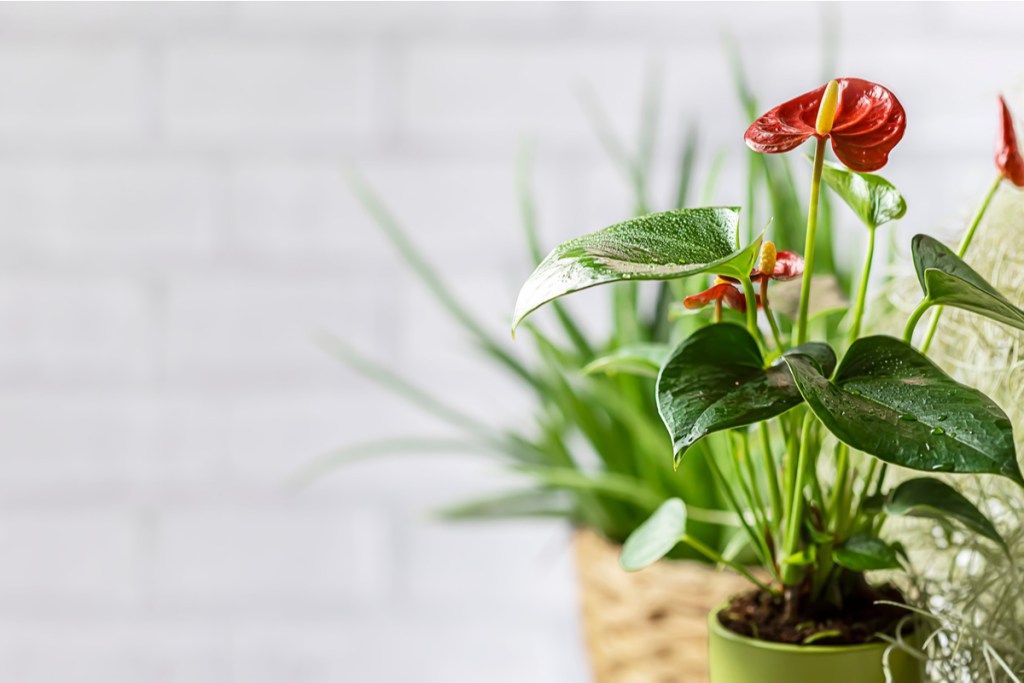Common as they may be in flower arrangements, anthuriums are easy to grow as potted plants. Even beyond their striking appearance at your local nursery or grocery store, you can get them to bloom throughout the year. For tips on how to get your anthurium plant to continually flower, keep reading ahead to cultivate the anthurium arrangement of your dreams.

What you need to know about anthuriums
The anthurium genus consists of about 1,000 plants. Along with their glossy, heart-shaped leaves, anthuriums feature striking, long-lasting flower spikes known as inflorescences — these have a large, flat spathe surrounded by a thin, arched, or helix spadix. One of the most common anthuriums, the scherzerianum, or flamingo flower, shows off leathery, lance-shaped leaves and waxy red spathes with an orange spadix. Besides red, you may also find plants with white, orange, yellow, or purple spathes.
When it comes to care, anthuriums have a somewhat picky reputation. Coming from the rainforests of South and Central America, they appreciate tropical environments, so bright indirect light and high humidity can do them a lot of good — though higher maintenance than your typical pothos, they’re not too difficult to grow. Warm temperatures are also ideal for these showy plants — a sweet spot between 70 to 85 degrees Fahrenheit is ideal.
How anthuriums bloom
Anthuriums flaunt gorgeous heart-shaped leaves, but they’re perhaps best known for their colorful, striking blooms. Luckily, the flowers aren’t a one-and-done deal — you can get an anthurium plant to flower again with some coaxing by way of excellent care. Before we go into bloom-boosting techniques, here’s what you need to know about the anthurium bloom cycle.
How often do anthurium plants bloom?
During the summer, anthuriums typically put out blooms that can last eight weeks or longer. That said, they can bloom throughout the year under the right conditions. If you notice drooping, brown flowers, know that it’s normal for anthurium flowers to wilt after they’ve run their course. Once a flower wilts, simply prune it back so that your plant can redirect its energy towards growing new leaves and blooms.
Will an anthurium bloom again?
If you bought your anthurium at the store due to its beautiful flowers, don’t despair if they die back. The blooms have a lifespan of around two to three months, and you can get as many as four to six new flowers per year. Keeping your plant healthy will help it produce the most blooms possible — we’ll talk more on how to do that below.

How to get an anthurium to bloom
Supply your anthurium with extra light.
Anthuriums do well in dappled or medium-light — after all, they originally came from forests where they grew beneath tree canopies and other large plants. That said, the more bright indirect light you can give your anthurium, the more inflorescences it can potentially have. Plus, light will also help your spathes develop a bolder color instead of reverting to green. If you don’t naturally receive enough light in your home, consider supplementing your plants with a grow light throughout the day.
Fertilize your anthurium.
So what is the best fertilizer for your anthurium? Anthuriums appreciate getting nutrients from a balanced fertilizer on a monthly or bimonthly basis throughout the growing season. But if flowering is your endgame, invest in a bloom booster formula (which you might find marketed towards orchids) that has a high phosphorus concentration. You could also use organic materials such as kelp and worm castings to richen your soil.
And speaking of soil, you’ll want a relatively well-draining mix: Equal parts perlite, peat moss, and orchid bark should do the trick. Anthuriums are epiphytic, which means they attach to tree trunks and rocks without the need for soil — their roots are surrounded by air in their natural habitat. So if you’re growing your plant in a potting mix, make sure that it’s well-draining and well-aerated.
Give your anthurium more humidity.
Anthuriums have been mass-produced and hybridized greatly, so chances are that your grocery store anthurium won’t need all that much humidity to survive. As long as you don’t leave your plant by a drafty window or air conditioner, it should be fine for the most part. However, humidity can encourage blooming and a beautiful glossy finish and flowers do best with 70 to 80 percent humidity. The easiest way to give your plant humidity, of course, is by keeping it next to a humidifier. But you can also leave your plant on a tray of wet pebbles to amp up the humidity or group it next to other plants. When you increase the humidity, give your plant sufficient air circulation to prevent fungus and pest issues.
If you’ve ever wondered how to maintain those beautiful blooms on your grocery store anthurium, you won’t need to fret. While these plants might have a reputation for being finicky, they’re more resilient than you think. With an increase in light, fertilizer, and humidity, you’ll be setting the ideal conditions for those lovely flowers to appear.
Editors' Recommendations
- Stunning Monstera plants that you should add to your indoor plant collection
- Beautiful, low-maintenance pothos varieties to add to your plant collection
- Your guide to rubber plant care and the best varieties to add to your home
- Do ZZ plants cause cancer? Here’s the definitive answer
- Are these common houseplants safe for your cat? Read this guide to find out the scoop




